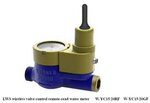hamed8419215
Member level 5
hi.
for an AMR like system for water meters, i want to choose a frequency band. currently i want to use RFM23B (Based on SI4431-revB1) and in my country available ISM bands are 434MHz and 915MHz. and water meters are typically 50cm under ground. with these situation, which frequency band is suitable?
(the TX deviation is +-38.4KHz and FHSS is not required).
for an AMR like system for water meters, i want to choose a frequency band. currently i want to use RFM23B (Based on SI4431-revB1) and in my country available ISM bands are 434MHz and 915MHz. and water meters are typically 50cm under ground. with these situation, which frequency band is suitable?
(the TX deviation is +-38.4KHz and FHSS is not required).
